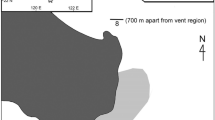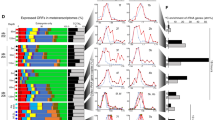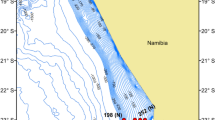Abstract
The large quantities of reduced carbon that are required to support the filter-feeding mytilid mussels (Mytilus sp.), vesi-comyid clams (Calyptogena sp.) and various other animals in the Galápagos hydrothermal vent systems are thought to be derived from either the in situ synthesis of particulate organic matter by chemoautotrophic, sulphide-oxidizing bacteria1,2 or by the advection of sedimentary organic carbon into the vent environment from surrounding areas3,4. In contrast, the dense populations of vestimentiferan tubeworms (Riftia pachyptila), which lack mouth organs and digestive tracts, apparently utilize organic carbon synthesized by symbiotic chemoautotrophs5. We present evidence here, based on 14C activities and 13C/12C ratios, that the principal source of dietary carbon for mussels and tubeworms is derived from the dissolved inorganic carbon (DIOC) in the vent effluent waters.
This is a preview of subscription content, access via your institution
Access options
Subscribe to this journal
Receive 51 print issues and online access
$199.00 per year
only $3.90 per issue
Buy this article
- Purchase on Springer Link
- Instant access to full article PDF
Prices may be subject to local taxes which are calculated during checkout
Similar content being viewed by others
References
Jannasch, H. W. & Wirsen, C. O. Bioscience 29, 592–598 (1979).
Karl, D. M., Wirsen, C. O. & Jannasch, H. W. Science 207, 1345–1347 (1980).
Lonsdale, P. Deep-Sea Res. 24, 852–863 (1977).
Enright, J. T., Newman, W. A., Hessler, R. R. & McGowan, J. A. Nature 289, 219–221 (1981).
Cavanaugh, C., Gardner, S. L., Jones, M. L., Jannasch, H. W. & Waterbury, J. B. Science (in the press).
Williams, P. M. & Gordon, L. I. Deep-Sea Res. 17, 19–27 (1970).
Eadie, B. J., Jeffrey, L. M. & Sackett, W. M. Geochim. cosmochim. Acta 42, 1265–1269 (1978).
Corliss, J. B. et al. Science 203, 1073–1083 (1979).
Cobler, R. & Dymond, J. Science 209, 801–803 (1980).
Turekian, K., Cochran, J. K. & Nozaki, Y. Nature 280, 385–387 (1979).
Craig, H. & Weiss, R. F. J. geophys. Res. 75, 7641–7647 (1970).
Rau, G. H. & Hedges, J. I. Science 203, 648–649 (1979).
Rau, G. H. Science (in the press).
Östlund, H. G., Brescher, R., Oleson, R. & Ferguson, M. J. Univ. Miami Rosenstiel School Mar. Atmos. Sci. Tritium Lab. Data Rep. 8, (1979).
Druffel, E. M. Geophys. Res. Lett. 8, 59–62 (1981).
Broecker, W. S. & Olson, E. A. Radiocarbon 3, 176–204 (1961).
Wooster, W. S. Prelim. Rep. Step-1 Exped. 15 Sept.–l4Dec. 1960, PartI. Phys. chem. Data, SIO ref. no. 61-9 (1961).
Welhan, J. Trans. Am. geophys. Union (EOS) 61, 992 (1980).
Author information
Authors and Affiliations
Rights and permissions
About this article
Cite this article
Williams, P., Smith, K., Druffel, E. et al. Dietary carbon sources of mussels and tubeworms from Galápagos hydrothermal vents determined from tissue 14C activity. Nature 292, 448–449 (1981). https://doi.org/10.1038/292448a0
Received:
Accepted:
Issue Date:
DOI: https://doi.org/10.1038/292448a0
This article is cited by
-
Carotenoids indicate differences in diet of the hydrothermal vent crabBythograea thermydron (Brachyura)
Marine Biology (1990)
-
Stable isotopic compositions of hydrothermal vent organisms
Marine Biology (1989)
-
The importance of methane and thiosulfate in the metabolism of the bacterial symbionts of two deep-sea mussels
Marine Biology (1987)
-
Ultrastructure of the gill of the hydrothermal-vent mytilid Bathymodiolus sp.
Marine Biology (1986)
-
Stable isotope evidence for chemosynthesis in an abyssal seep community
Nature (1985)
Comments
By submitting a comment you agree to abide by our Terms and Community Guidelines. If you find something abusive or that does not comply with our terms or guidelines please flag it as inappropriate.



